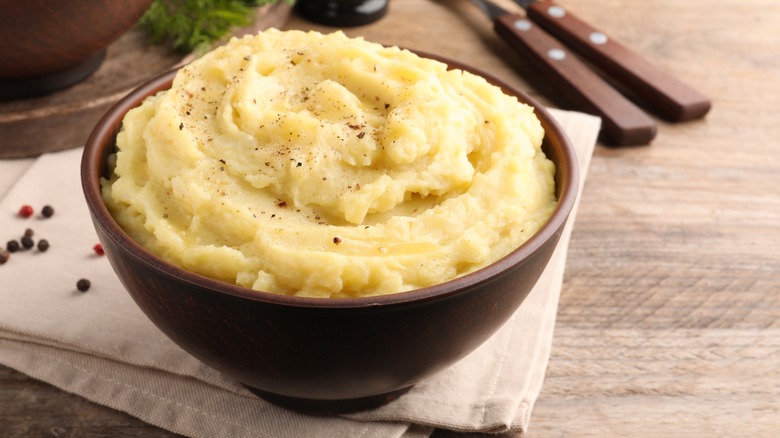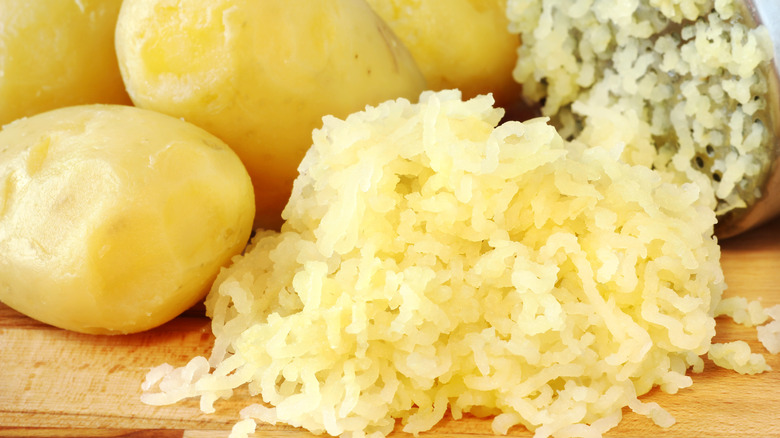Guy Fieri's Potato 'Snow' Makes The Smoothest Mash
Few side dishes are considered as delicious as the iconic mashed potato. Whether you're making a simple mash or incorporating savory add-ons like garlic or bacon bits, this popular recipe consists of boiled spuds crushed into a pillowy puree, and seasoned to perfection with a dash of salt, pepper, butter, and heavy cream. But when it comes to making this relatively simple dish, many inexperienced home cooks end up with a gluey, downright inedible mash. Luckily, world-renowned restaurateur Guy Fieri actually has a tip on how to avoid this problem, and it relies on using a ricer to make potato "snow."
Potatoes are finicky vegetables, whose starches can easily rupture and turn gummy if handled too much. Most home cooks don't run into this problem with potatoes unless they're dealing with a pureed dish such as a mash, which requires you to manipulate entire spuds into a pulp. A ricer takes care of that problem by finely breaking down boiled potatoes into "snow" in just one go, giving you more wiggle room to mix in those add-ons without messing up its structure.
Ricers are actually more efficient than potato mashers
Despite their name, potato mashers are not the most efficient way to mash potatoes. Because you essentially have to crush your spuds multiple times to get a smooth mash, you won't be able to replicate the pillowy texture that a ricer gets you. Potato mashers aren't completely terrible, however. You can still give your mashed potatoes a creamy mouthfeel with them, especially if you strategically crush your spuds by minimizing the number of times you have to mash and splash in a bit of milk or heavy cream to help things along.
Ricers aren't universally perfect when it comes to mashing potatoes. Because ricers are only able to finely grate boiled potatoes, you won't be able to have a heterogenous texture in your mash. So if you like lumps in your mashed potatoes and don't mind skipping out on a fluffy texture, opt for the masher.
Do not even begin to think about mashing potatoes with a food processor or another high-speed pulverizer. The force of their blades will only destroy the starches of your spuds and leave you with an unsavory potato goop. At that point, even a fork would do a better job at mashing.
Other tips for making smooth, airy mashed potatoes
The potatoes you choose to mash are equally as important as the instrument you're mashing them with. Generally speaking, the best potatoes for fluffy mashed potatoes are the russet and Idaho, as they provide a higher starch content in comparison to waxier variants such as fingerlings. Since starches are the primary reason why potatoes turn out fluffy when cooked, more is better when it comes to making a mash. Some chefs, however, like to throw in a few waxy or all-purpose Yukon Golds to fortify the taste of their mash, so feel free to experiment with your potato combinations until you get your desired result.
After you're done boiling your spuds, don't go straight to mashing right away. Residual water on the surface of your potatoes will only weigh down your mash, and enough could make its consistency resemble a slushy. To avoid this problem, simply drop your spuds in a colander or strainer, and allow the moisture to drip or evaporate off your potatoes for a few minutes. You can accelerate this even further by dropping your strained potatoes into the (now empty) hot pot you used to boil.



